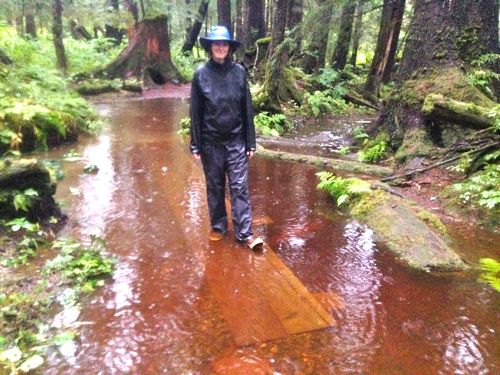
Hiker Brandie Cheatham puts every inch of her XTRA TUFF boots to the test on the Indian River trail during flooding in Sitka in 2014. Weather fans can now report such events using the mPing app.
(Brian McNitt photo)
After a record-setting weekend, temperatures have dropped to a more normal range in Sitka and elsewhere around Southeast. Sitka topped 60 degrees three times over the MLK Day weekend — Annette Island recorded a high of 65 on January 14.
Over the past couple of decades satellites, computers, and remote data collection have made huge advances in weather forecasting possible. But now the National Weather Service is bringing online one of the most sophisticated weather observation tools ever — regular people.
Of course it’s an app. You can download it for your smartphone from the App Store. Android users can find it at Google Play.
“This app was actually developed initially to help calibrate radars.”

The mPing app is available for iOS devices at the App Store. MPing for Android is available at Google Play.
David Levin is a forecaster with the National Weather Service in Juneau. He says the technology was developed in 2012 at the National Severe Storms Laboratory in Oklahoma.
“When we first came out with what’s called dual-pol radar technology. It allows you to see the shape and the type of precip, as opposed to just how much precip is out there. But they weren’t sure how well it was actually doing, so they developed this app where people can tell you what kind of precip was occuring at their location. Then they could look on the radar and see what was happening and calibrate those precip types that way.”
And so mPing was born. It stands for Meteorological Phenomena Identification Near the Ground. MPing combines the Global Positioning capabilities of your phone — which is the technology behind Google Maps — with old school weather observation. It’s crowdsourced weather data, and Levin says it’s been especially useful in the lower 48 to track the intensity of severe storms. In populated areas, the accumulating pings as people track and report weather start to resemble a kind of human radar.
In Alaska, where low population density is the rule, the mPing app is serving a slightly different role.
“Up here we’ve actually found it useful for some of the areas where we don’t have weather observation equipment. It’s really kind of hard sometimes to tell what’s going on in some of these more remote communities.”
Levin says forecasters have realtime access to data from mPing. The pings arrive — in this case — on a big map of Southeast Alaska. And they’re graphic: Snowflakes appear when someone reports snow; raindrops appear for rain. The app has a dropdown menu of the kinds of things you can report — like drizzle or ice pellets — and it also allows you to report storm damage, like uprooted trees.
And Levin says you can also report nothing. As in: Nice weather.
“Believe it or not that’s actually kind of helpful. If we have a forecast out for heavy snow and it’s not actually doing anything — that would be an example where ‘nothing’ would be helpful.”
So whether a lot of people download and use mPing, or whether just a few people use it in places where forecasters have no remote tools, the app will contribute to making better weather forecasts. If I were a betting man, I’d say mPing is going to catch on. People like talking about the weather; now they can ping it right to a screen in front of the weather guy himself.
KCAW – Well, thanks a lot for your time, David. We’ll get something on the air, and I’ll get a link to this on our website so people can download it and start using it.
Levin – Sounds good. We just got a test ping from Sitka. Maybe that was somebody there that was…
KCAW — …Sensing our conversation? It happens!
And so begins what might become the mPing flood.































